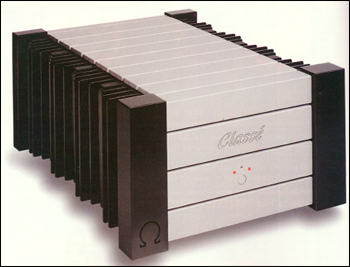| Columns Retired Columns & Blogs |
Classé Omega power amplifier
What fascinates me about the High End are the electric personalities behind it. Manufacturers typically invest so much of themselves in the products they make. It's a divine madness—they do it because they have to. They're driven to it with a real sense of mission and excellence. But God forbid you criticize any of their offspring...ooo-la-la!
The Classé Omega may be manufactured in Canada but it reflects the nature of its creator, Mike Viglas. He's from Greece, you see, a classic Mediterranean guy. Let's say that Mike's got a serious case of joie de vivre. He's not hung up about it. Sensuality is important to him—he likes to eat well and have a good time. So does his amplifier.

A manly beast
The Omega is a handsome, manly beast. Its backbreaking, 250-lb. weight is nicely offset by its black-edged, "soft-shadow," brushed-aluminum cladding, supported by huge square black towers at the four corners. The chassis itself is made of nonmagnetic steel, and the thick-as-the-dickens heatsinking, also in chic black, is built up of bolted-together modules, with vertical fins that are double-width at section joins. But, beefy though it is, the heatsinking isn't very elaborate, and doesn't have to be. The Omega runs class-A up to 110Wpc, then tips into class-AB at power levels above that. It got nice'n'toasty after an hour or two of high-decibel onslaught, but never turned into an oven.
The interior is also a treat for the audiophile eye. It's all polished high-tech in there, the huge double-toroid transformers up front adding the aura of an exotic engine—a Gandini-era V-12 Lamborghini, perhaps?
The Omega is actually two completely separate amplifiers within a single chassis. The two huge transformers (2500VA each) sport their own power cords (Cardas Goldens, supplied) and feed a main storage capacity—90,000µF per side—made up of a number of small capacitors. There are 16 bipolar (high-voltage, high-current) output transistors per side, for a grand total of 32. Audiophile goodies abound: metalized polypropylene capacitors bypass each output device, and you'll find four large Solar metalized polypropylenes on the DC supplies of each dual-mono section. Two heavily gold-plated bars connect the output transistors' voltage supplies, all wiring is of oxygen-free copper, and all signal-carrying cables are Litz-shielded "to minimize skin effect."
'Round back, the Omega's luxurious demeanor continues with heavily gold-plated balanced (XLR, pin 2 hot) and single-ended (RCA) input connectors above, and four large, gold-plated output terminals below. The custom posts are battened down with a supplied nut-driver of top quality. They don't fool around in Canada when it comes to their tools, eh? Two sets of generously spaced outputs make for easy biwiring, although our JMlab Utopias take a single-wire input. The outputs are well marked for bridged operation should the urge for greater power overcome you. But careful—one of the positive output terminals becomes negative in bridged operation.
Manual: "Please remember that the negative output connection of a bridged amplifier is not a ground. Do not use a common-ground switch-box setup. Do not use with electronic crossovers which have a common ground. Connecting two bridged amplifiers to a common-ground device of any sort will cause the amplifiers to fail." And: "Floating the ground, or defeating the ground on a 3-prong line cord, may create a shock hazard." At the power levels we're fooling with here, you're advised to pay attention. I mention bridged operation because, incredibly, we had two of these monsters in our system. Can you dig it? 3000W into 4 ohms!
The rear panel also sports a pair of switches that select single-ended or balanced input, and stereo or bridged mode. The switches won't operate when the amp is on—a smart and thoughtful touch. At $15k, you deserve the kitchen sink. Two LEDs, one on either side of the power switch up front, tell the tale for operating and fault conditions. (The Omegas performed flawlessly throughout the review period.)
- Log in or register to post comments




































